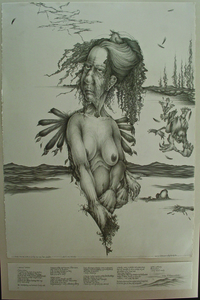

Loy McWhirter drew her inspiration from "Aries."
Val Lyle asked Loy McWhirter to join the"Mapping the Cosmos" exhibit at William King Museum of Arts. When it came time to draw her inspiration topic for the show McWhirter says that she "didn't want any particular topic, because I didn't know what to expect; and so I expected just about anything. I am glad for the topic got - Aries - because the most obvious aspects of Aries are things with which I am struggling in my own life path, both of late and abidingly."
She says that her approach to interpreting Aries was to "be as open minded/hearted as possible, and to remain as inclusive as I could throughout. This approach helped me to deepen my own understanding of the myriad possible meanings of the "sheroic' (McWhirter's word) warrior's journey and ordeal that each of us engages in, as we are called to live everyday as fully as can be. In our time above ground, I believe that we are meant to leave the great mother, Gaia, better than we found her when we came into being,among all the diverse creatures and habitats of her inclusive creation – and not just keep ourselves and each other limited by the exclusive considerations that concern the
blatantly unbridled and unsustainable myopia of our own species."
Her beliefs translate into the title of her poem for the "Mapping the Cosmos"exhibit, "great te mothre gaia's timelye timelesse halleluh neinne worrierre warrior reequologye mudrahe mirrorre; cosmos/aries."Her art piece is a graphite drawing and accompanying poem. The drawing portion of the piece is called, "a birde inne the hairre is worthe two inne the bushe."
As McWhirter describes it, "the great mother of all is looking for/at/into each of us, eye-to-eye, as we have fallen from her good graces, into which we are born. She is searching in 'the bush,' it might be said, for a bird that will fly; since the ones 'in hand' are falling out of the sky around her ears. Meanwhile, the bird in her hair is crowing, like the proverbial kookaburra in the old gumtree; eyes closed, and too full of itself to see the disappearing world all around its last safe perch, in the great mother, Gaia's, hair. In my observation/experience/understanding of the real world, we have gotten on her last nerve and are blindly dancing there, as if there were no tomorrow and no future generations
of every endangered species, including our own. The accompanying worrier warrior poem is about this, too."
She says her ongoing work consists mainly of drawing, line etching, stone lithography, poetry, singing, letterpress and some bookbinding. "I do most everything slowly and by hand and, given my life's experience, tend often toward a furious and satiric point of view. I believe this to be a good part of the work and gift to which every breathing artist/craftsperson is responsible and accountable. I often work in a series. I am drawn by the meaning and intention of drawing itself, working slowly and freehand,to suspend time and deepen the commitment to what I know. Carl Jung said, 'Often the hands know how to solve a riddle with which the intellect wrestles in vain,' and I have come to trust in this.
"I learned printmaking because I love to draw the intricate dark tones of line etching and stone lithography as implied color. Line etching is a particularly sinister medium that speaks eloquently to my wounded, sardonic worldview, acquired in the an aerobic underside of indoor religions' myriad guises.
"Until the age of 10, I lived in a cloistered religious sect in the jungle islands of rural Paraguay, which was based in the 14th-century European Anabaptists and in older secret societies. I now live and work where I grew up thereafter, in the rural mountains of western North Carolina. Here I built and maintain, with Bruce Greene, the hell bendre presse/leathre wingged itionnes print shop, which sustains my curiosity, devotion and constant practice.
"An irreverent devotion, drawing is what is left to me of religion. I am essentially both self-taught and influenced by everything and everyone at hand."
>>THERE'S MORE:
Ray Stratton gets inspiration from Halley's Comet